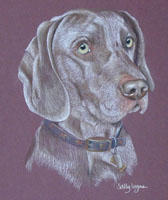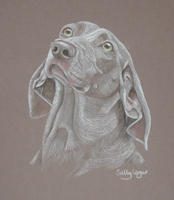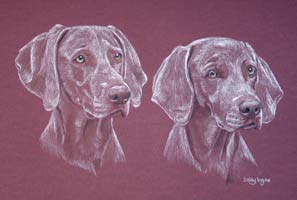Recent Pet Portraits
Search Archive
Dog Portraits
Cat Portraits
Horse Portraits
Rabbit Portraits
Sheep and Pigs
Farm Animals
Bird Portraits
People Portraits
People with Pets
Portraits of Children
Special Commissions
INFORMATION
Information
Portrait Order Form
Customer Comments
Contact
Prices
About the Artist
Gift Vouchers
Prints and Gifts
Taking Photos of Pets
Weimaraner Portraits in Pastel by UK animal portrait artist
Guaranteed good likeness - preview your portrait online prior to payment and dispatch!
|
Weimaraner portraits - Stobart and Holly
- Jake and Gem |
Weimaraner portraits by Sally Logue
Search the Dog Portrait Galleries for more weimaraners
Search for How do I commission a portrait of my weimeraner?
Weimaraners can make a good family dog with they will never be an 'easy pet'. They are good with children if brought up with children and the children respect the dog. The Weimaraner is not a breed that will 'play' with children as they get bored very easily.
They need lots of constant training as they can be very wilful and stubborn. They will tolerate other dogs, providing the other dogs accept that the Weimaraner is top dog. They eat around 400g of dried food per day, divided into 2 smaller meals.
The Weimaraner does not require much grooming as any mud that sticks to the coat is easily brushed off when dry. Although they do shed their fur they do not shed constantly and because it is so short it is not as noticeable. The Weimaraner is an active working gundog and needs lots of free running exercise per day as well as his brain exercising. If the Weimaraner gets bored and underexercised then he can become destructive and noisy. If you are looking for a dog to lie in front of the fire and look pretty then the Weimaraner is not for you. He likes human company and does not kennel well. He will follow you everywhere and gone are the days of being able to visit the toilet on your own.
The Weimaraner was originally bred in Germany by the Forresters who wanted a powerful dog to bring down large game, like deer and boar, they also wanted a dog that could retrieve the game shot by the forrester for the family stewpot, and last but not least he had to catch and kill the wild cats that lived in the forest surrounding the forresters home. The instinct to catch and kill cats is still very strong in the Weimaraner and care must be taken when introducing Weimaraners and cats. Purpose bred aggression in the Weimaraner must be recognised and controlled.
The Weimaraner as a breed can have problems with gastric torsion, which is when the gut twists and traps gas, this is an emergency and vet help must be sought immediately. Care should be taken when buying a Weimaraner Puppy and a reputable breeder should be consulted. The Breed Club has a list of members who have litters available. A well bred puppy from a reputable breeder will cost you around £500. Weimaraners are competent all-round sporting dogs. Towards their families they are affectionate and loyal but can be aggressive to strangers.
History
The Weimaraner is a German breed and has been in existence for at least two centuries. Named after the city of Weimar, which is the capital of the Land of Thuringen, these dogs were evolved by the Dukes of Weimar, probably from hounds and pointers so as to merge a number of qualities in one dog; tracking, scenting, pointing and retrieving - also obedience. Originally they were used in packs for hunting large game such as wild cat and bear. With the decline of such quarry and the development of firearms a new style of hunting was developing.
A dog that could hunt, point and retrieve smaller game from land and water was required. As a result of these changes the Weimaraner suffered a decline in numbers, but enthusiasts for the breed took the opportunity to improve and re-establish it. In order to achieve this they founded the Weimaraner Club in 1897. The rules of this newly formed club were strict: only approved dogs and bitches were to be used for breeding; no dogs were to be sold outside the club; and no dogs were to be exported from Germany. This last rule was relaxed in 1913 when a dog was introduced to Austria and again in the late 1920's when two dogs were sent to the United States.
The Weimaraner arrived in Great Britain in the 1950's. It is one of the five hunt, point and retrieve breeds to be imported from continental Europe since the Second World War. They are an energetic breed, with many talents and therefore should be properly trained.


